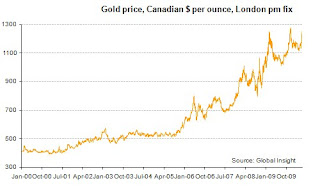Gold prices zoomed to nominal record highs based on the US dollar during the past two days. See chart below
 While much of the recent actions have been imputed to the events in the Eurozone, e.g. 'currency fears', gold's rise hasn't been a one-off affair, but a long term trend.
While much of the recent actions have been imputed to the events in the Eurozone, e.g. 'currency fears', gold's rise hasn't been a one-off affair, but a long term trend.
Likewise rising gold prices hasn't been limited to the US dollar but against global currencies.
Put differently, this means gold prices has risen across paper money over the long term and where the current pace of increases seem to be accelerating.
Below are charts of gold prices relative to different currencies, courtesy of gold.org.
As reminder, these charts were updated last May 10th and doesn't include the spike of the previous two days.
 While much of the recent actions have been imputed to the events in the Eurozone, e.g. 'currency fears', gold's rise hasn't been a one-off affair, but a long term trend.
While much of the recent actions have been imputed to the events in the Eurozone, e.g. 'currency fears', gold's rise hasn't been a one-off affair, but a long term trend.Likewise rising gold prices hasn't been limited to the US dollar but against global currencies.
Put differently, this means gold prices has risen across paper money over the long term and where the current pace of increases seem to be accelerating.
Below are charts of gold prices relative to different currencies, courtesy of gold.org.
As reminder, these charts were updated last May 10th and doesn't include the spike of the previous two days.
Gold prices in Canadian Dollar
There are two possible themes which record gold prices appear to be telling us:
One, since the symptoms of the monetary disorder (or inflationism) has been intensive and applied on a global scale, gold prices are seemingly being incorporated gradually as part of the global currency system.
And as Ludwig von Mises reminds us,
``The boom can last only as long as the credit expansion progresses at an ever-accelerated pace. The boom comes to an end as soon as additional quantities of fiduciary media are no longer thrown upon the loan market. But it could not last forever even if inflation and credit expansion were to go on endlessly. It would then encounter the barriers which prevent the boundless expansion of circulation credit. It would lead to the crack-up boom and the breakdown of the whole monetary system."
This leads us to the second theme, the growing risks of global hyperinflation.
As global governments continue to inflate the system to delay the day of reckoning, the rate of financing bailouts through money printing and through suppressed interest rates appear to be swelling. And all these appear to be enhancing the case of a crack-up boom or our Mises moment.
The original bailout for Greece at $146 billion (110 billion euros) didn't calm the markets. And it took a "shock and awe" or a Hank Paulson's bazooka approach of nearly $1 trillion (750 billion euro) to achieve some semblance of stabilization.
To paraphrase Senator Everett Dirksen ``A trillion here and a trillion there, and pretty soon you're talking real money; (gold as money)"
For now, every leakage that could bring about a global bust, would be fiercely met by the policies revolving around the printing press as solution, until the critical point where policymakers would have to decide whether to embrace market reality (declare a default or restructure) or let the printing presses rip. The latter would put an end to the current paper money system.
And we hope the world will come to their senses enough to realize the lunacy of inflationism, before it is too late.








No comments:
Post a Comment